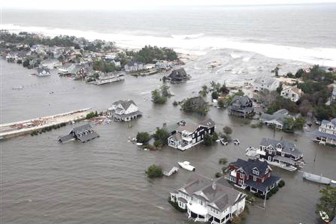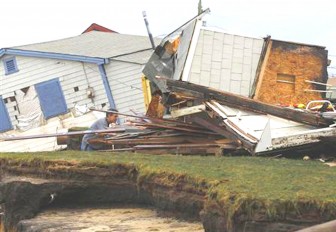NEW YORK, (Reuters) – Millions of people faced epic flooding and lengthy power outages yesterday after the massive storm Sandy wreaked havoc in much of the eastern United States with high winds and heavy rains.
The storm killed at least 45 people, including at least 18 in New York City, and insurance companies started to tally billions of dollars in losses.
The storm hit with just a week to go to the Nov. 6 presidential election, disrupting campaigning and early voting and raising questions about whether polling stations in some hard-hit communities would be ready to open by next Tuesday.
Sandy, which crashed ashore with hurricane-force winds on Monday near the New Jersey gambling resort of Atlantic City, was the biggest storm to hit the country in generations.

It swamped parts of New York’s subway system and lower Manhattan’s Wall Street district, closing financial markets for a second day.
Businesses and homes along New Jersey’s shore were wrecked and communities were submerged under floodwater across a large area. More than 8 million homes and businesses in several states were without electricity as trees toppled by Sandy’s fierce winds took down power lines.
Across the region, crews began the monumental task of restoring power for anxious customers and getting transportation up and running could take time after the storm caused nearly 16,000 flight cancellations.
Cellphone service outages were widespread in many states and even some emergency call centers were affected.
The storm reached as far inland as Ohio and parts of West Virginia were buried under 3 feet (1 meter) of snow, a boon for ski resorts that was one of the storm’s few bright spots.
Some cities like Washington, Philadelphia and Boston were spared the worst effects of the storm and were ready to return to normal by today. But New York City, large parts of New Jersey and some other areas will need at least several days to get back on their feet.
“The devastation is unthinkable,” New Jersey Governor Chris Christie said after seeing pictures of his state’s shore.
Seeking to show he was on top of the aftermath of the storm in the nation’s most densely populated region, the White House said President Barack Obama planned to tour damaged areas of New Jersey today accompanied by Christie.

The New Jersey governor, who has been a strong supporter of Republican presidential challenger Mitt Romney, praised Obama and the federal response to the storm.
“New Jersey, New York in particular have been pounded by this storm. Connecticut has taken a big hit,” Obama said during a visit to Red Cross headquarters in Washington.
Obama issued federal emergency decrees for New York and New Jersey, declaring that “major disasters” existed in both states.
AREA ‘COMPLETELY LEVELED’
Power outages darkened large parts of Manhattan and a fire destroyed more than 80 homes in New York City’s borough of Queens, where flooding hampered firefighting efforts.
“To describe it as looking like pictures we’ve seen of the end of World War Two is not overstating it. The area was completely leveled. Chim-neys and foundations were all that was left of many of these homes,” said New York Mayor Michael Bloomberg after touring the area.
Neighborhoods along the East and Hudson rivers bordering Manhattan were underwater and expected to be without power for days, as were low-lying streets in Battery Park near Ground Zero, where the World Trade Center once stood.
“I’m lucky to have gas; I can make hot water. But there is no heating and I’m all cold inside,” said Thea Lucas, 87, who lives alone in Manhattan’s Lower East Side.
Further north, though, many retail stores, restaurants and bars reopened in neighborhoods that did not lose power.
In Brooklyn’s Prospect Park, runners, dog-walkers and children were out and about among fallen trees.
Organizers of Sunday’s New York City Marathon were left scrambling. The world’s largest 26.2-mile footrace typically has over 47,000 entrants from around the world, deploys thousands of volunteers, and winds through all five boroughs.
One disaster modeling company said Sandy may have caused up to $15 billion in insured losses. That would make it the third-costliest hurricane on record, behind hurricanes Katrina, which laid waste to New Orleans and the Gulf Coast in 2005, and Andrew, which devastated parts of Florida in 1992.
While damage was still being assessed, federal authorities made $13 million in “quick release” emergency relief funds available to New York and Rhode Island.
CAMPAIGNING ON HOLD
Obama and Romney put campaigning on hold for a second day, but Romney planned to hit the trail again in Florida on Wednesday and Obama seemed likely to resume campaigning on Thursday for a final five-day sprint to Election Day.
Obama faces political danger if the government fails to respond well, as was the case with predecessor George W. Bush’s botched handling of Katrina. Obama has a chance to show not only that his administration has learned the lessons of Katrina, but that he can take charge and lead during a crisis.
All along the East Coast, residents and business owners found scenes of destruction.
“There are boats in the street five blocks from the ocean,” said evacuee Peter Sandomeno, one of the owners of the Broadway Court Motel in Point Pleasant Beach, New Jersey. “That’s the worst storm I’ve ever seen, and I’ve been there for 11 years.”
Sandy, which was especially imposing because of its wide-ranging winds, brought a record storm surge of almost 14 feet (4.2 meters) to downtown Manhattan, well above the previous record of 10 feet (3 meters) during Hurricane Donna in 1960, the National Weather Service said.
Water poured into the subway tunnels under New York City. Bloomberg said the subway system, which normally carries over 5 million people each weekday, would likely be closed for four or five days.
“Hitting at high tide, the strongest surge and the strongest winds all hit at the worst possible time,” said Jeffrey Tongue, a meteorologist for the weather service in Brookhaven, New York.
Hurricane-force winds as high as 90 miles per hour (145 km per hour) were recorded, he said.
The community of Atlantique Beach on Fire Island, New York, took the storm’s brunt and lost most of its oceanside dunes. Some homes were pushed off their foundations.
The U.S. Department of Energy said more than 8 million homes and businesses in several states were without electricity due to the storm. In many communities residents anxiously awaited the arrival of utility crews. Some gas stations in Queens, New York, ran out of fuel, and shoppers found supermarkets short of fresh meat, bread and potatoes.
The flooding hampered efforts to fight a massive fire that destroyed more than 80 homes in Breezy Point, a private beach community on the Rockaway barrier island in Queens.
Besides the deaths in New York City, others were reported in New York state, Massachusetts, Maryland, Connecticut, New Jersey, Pennsylvania, Virginia and West Virginia. Toronto police also recorded one death – a woman hit by flying debris. Sandy killed 69 people in the Caribbean last week.
U.S. government offices in Washington and schools up and down the East Coast but were due to reopen today.
U.S. stock exchanges are expected to reopen today, and the passenger rail service Amtrak will restart services on some of its busiest routes on a limited basis.









